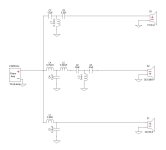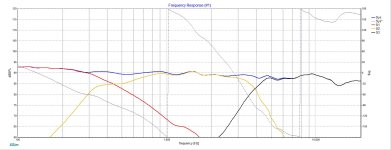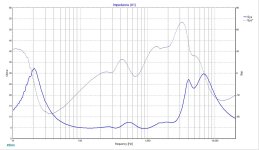I appreciate all the support and comments. I might be going about this backwards but just trying to get my head around cossover design and all the parameters I need to be aware of before actually attempting to build a prototype. As for the box itself, that's still some months away, so yeah, I'm giving myself some time to get my head around all of this, aware that there will likely be many iteractions before I'm happy with the final result🙏
P.S. I can't get my head around the phase traces. I understand how to manipulate them, but in doing so I destroy my frequency response. Allen advised me to disregard for now, but I'm kinda treading water until I can find a way to move the design forward.
P.S. I can't get my head around the phase traces. I understand how to manipulate them, but in doing so I destroy my frequency response. Allen advised me to disregard for now, but I'm kinda treading water until I can find a way to move the design forward.
When two responses come together and phase is also the same, you’ll get summation of 6dB higher than the individual responses. When they’re 90 degrees apart they’ll only sum to 3dB higher. When they’re greater than 90 degrees apart they are working against each other and will move towards a condition of cancellation.
I've read many of your comments on the subject Allen, your knowledge re crossovers is substantial, and I've kinda got my head around the whole out of phase conundrum, but what I can't find is how to manipulate the traces without destroying the frequency response. Is it a case where I need to comprimise between the two, do I need to add components, is a near flat frequency response actually the holy grail, the way forward is unclear to me. 🤔
How the majority of you talk about this subject, with such fluidity, makes me feel like a dumbass. I'm not educated in electronics, just thought it would be a fun project, being forced into retirement, but I don't know, maybe it's way outside of my limited abilities. I'm apporching this like a Meccano set, just trying different things until it looks kinda right, not having any understanding as to how/why components interact the way they do, and honestly, I don't think I have the mental capacity to gain that level of comprehension.
How the majority of you talk about this subject, with such fluidity, makes me feel like a dumbass. I'm not educated in electronics, just thought it would be a fun project, being forced into retirement, but I don't know, maybe it's way outside of my limited abilities. I'm apporching this like a Meccano set, just trying different things until it looks kinda right, not having any understanding as to how/why components interact the way they do, and honestly, I don't think I have the mental capacity to gain that level of comprehension.
All you really need is a baffle the size you plan on making your loudspeaker. It will provide you with a reasonable amount of real measurement information. The low end response you can reasonably simulate.As for the box itself, that's still some months away, so yeah, I'm giving myself some time to get my head around all of this, aware that there will likely be many iteractions before I'm happy with the final result🙏
Mark
On the contrary, it shows you are recognising what a big topic it is.makes me feel like a dumbass.
Post your Xsim save file and describe the trouble you're having. Some of us may find the reason.Is it a case where I need to comprimise between the two, do I need to add components,
It's proving to be more complicated than I thought, which goes to show how niave I was, or arrogant, but either way, I'm going to either be satisfied that the design will be somewhere within the region of functioning as intended, or I'll walk away and invest the money into a secondhand pair, gaing some valuable experince as I refurbish them.
As requested though, I've attached the XSim file. There may be many issues, I only see what I see, but as you have previously pointed out, the phase traces are an issue. I can't correct them without comprimising the frequency responses, which highlights my lack of knowledge.
As requested though, I've attached the XSim file. There may be many issues, I only see what I see, but as you have previously pointed out, the phase traces are an issue. I can't correct them without comprimising the frequency responses, which highlights my lack of knowledge.
Attachments
You have chosen a very difficult one indeed, so I can understand your frustration. You clearly have skill, so I think you should start with a different example.
The responses in this case are difficult to work with and the manipulations you have to do are tricky.
It might be explained by describing the primary reason a 3-way is said to be more challenging than a 2-way. The high pass and low pass of the midrange affect each other's phase on both ends. The tweeter crossover does not naturally include the extra phase shifts associated with that, and neither do the woofer's.. so you need to employ manipulations to make it work.
In your case you also have the woofer low end rolloff affecting phase outside of the crossover you're trying to control. Since you haven't measured the separation distances or the baffle step, it would be no more than an excercise to try.
If you want to practice you could find a regular midwoofer and dome tweeter and try to get it straight without any tricks. Preferrably with just second order filters and a resistor, or similar.. then branch out.
The responses in this case are difficult to work with and the manipulations you have to do are tricky.
It might be explained by describing the primary reason a 3-way is said to be more challenging than a 2-way. The high pass and low pass of the midrange affect each other's phase on both ends. The tweeter crossover does not naturally include the extra phase shifts associated with that, and neither do the woofer's.. so you need to employ manipulations to make it work.
In your case you also have the woofer low end rolloff affecting phase outside of the crossover you're trying to control. Since you haven't measured the separation distances or the baffle step, it would be no more than an excercise to try.
If you want to practice you could find a regular midwoofer and dome tweeter and try to get it straight without any tricks. Preferrably with just second order filters and a resistor, or similar.. then branch out.
That's definately simplified, but looks good. My only issue with it is the 4ohms load, as I have an old 80w Sansui which wasn't designed to run those loads, it can, but only running a low to medium volume and ideally not for very long. I'll be upgrading next year, so this might be a moot point, but I do like your work, it's definately giving me something to think about.
Not real work, was just a quick twist on Stormbringer's work. As an example in simplification and trade-offs. BTW here's pictures for all to see without having to run Xsim. Also L1 C1 values further altered a bit for better Zmin nearer to 5Ω.
Attachments
I've been contemplating buying some old speakers to experiemnt on
That's exactly what I did to get started....
https://community.klipsch.com/index.php?/topic/168930-kg-55-update-25way-conversion/
I'm definately approaching this back to front, so buying an old pair and refurbishing them, gaining an understand of crossovers in general and how the various components interact, as well as brushing up on my diagnostic and soldering skills, is probably the wise move here.
I've got 2 local options, a pair of B&W DM 220i's or Optonica CP-2525H's, 2.5 vs 3 way, both getting reasonable reviews, although the Optonica's seem more reveered by audiophiles???🤔🤷♂️
I've got 2 local options, a pair of B&W DM 220i's or Optonica CP-2525H's, 2.5 vs 3 way, both getting reasonable reviews, although the Optonica's seem more reveered by audiophiles???🤔🤷♂️
- Home
- Design & Build
- Software Tools
- XSim free crossover designer


